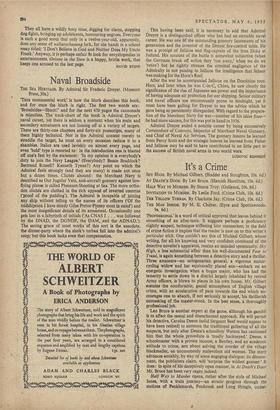Naval Broadside
'THIS monumental work' is how the blurb describes this book, and for once the blurb is right. The first two words are: 'Broadsides—Shoot 1' and for the next 450 pages the cannonade is relentless. The track-chart of the book is Admiral Dreyer's naval career, yet there is seldom a moment when his main and secondary armaments are not loosing off at a variety of targets. There are thirty-one chapters and forty-six postscripts, many of them highly technical. Nor is the Admiral content merely to straddle the target, ho must on every occasion reduce it to a shambles. Italics are used lavishly on almost every page, and even 'bold' type is resorted to: in the introduction one is blasted off one's feet by the statement: 'In my opinion it is everybody's duty to join the Navy League.' (Everybody? Bessie Braddock? Bertrand Russell? Kenneth Tynan?) Any point on which the Admiral feels strongly (and they are many) is made not once but a dozen times. Clichés abound : the Merchant Navy is described as Our Jugular Vein, anti-aircraft gunnery against low- flying planers is called Pheasant-Shooting at Sea. The more ortho- dox clichés are clothed in the rich apparel of inverted commas ('proof of the pudding'). The Admiral is incapable of joining any ship without telling us the names of its officers ('Of the midshipmen I have sturdy Giles Pretor-Pinney most in mind') and the most insignificant details of its armament. Occasionally one gets lost in a labyrinth of initials (`As CNAS I . . . was followed by the DNAD, the DGNDP, the DAM, and the ADNAD.'). The saving grace of most works of this sort is the anecdote, the dinner-party where the sheik's turban fell into the admiral's soup; but this book lacks even that compensation.
This having been said, it is necessary to add that Admiral Dreyer is a distinguished officer who has had an enviable naval career. He was one of the outstanding gunnery lieutenants of his generation and the inventor of the Dreyer fire-control table. He was a protégé of Jellicoe and flag-captain of the Iron Duke at Jutland. His account of the battle is somewhat subjective (when the Germans break off action they 'run away,' when we do we 'retire') but he rightly stresses the criminal negligence of the Admiralty in not passing to Jellicoe the intelligence that Scheer was making for the Horn's Reef.
After the war he accompanied Jellicoe on the Dominion tour. Here, and later when he was C-in-C, China, he saw clearly the significance of the rise of Japanese sea-power and the importance of having adequate air protection for our shipping. Senior military and naval officers are uncommonly prone to hindsight, yet it must have been galling for Dreyer to see the advice which he gave being so persistently disregarded. With regard to the prepara- tion of the Merchant Navy for war—another of his idees fixes— he had more success, for this was put in hand in 1936.
Admiral Dreyer ended a notable career by being successively Commodore of Convoys, Inspector of Merchant Naval Gunnery, and Chief of Naval Air Services. The gunnery lessons he learned from Percy Scott and the strategic lessons he learned from Fisher and Jellicoe may be said to have contributed in no little .part to the success of British naval arms in two world wars.
LUDOVIC KENNEDY










































 Previous page
Previous page